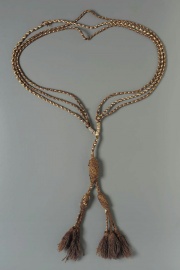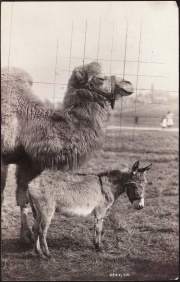Difference between revisions of "Camel hair"
| (One intermediate revision by the same user not shown) | |||
| Line 13: | Line 13: | ||
== Physical and Chemical Properties == | == Physical and Chemical Properties == | ||
| − | Fiber length 30 cm (outer hairs); 2.5-15 cm (undercoat) Tensile strength = 1.78 g/d Elongation = 39-40% Moisture regain = 13% Cross section is circular to oval. Medulla is narrow and continuous. Density = 1.32 | + | * Fiber length 30 cm (outer hairs); 2.5-15 cm (undercoat) |
| + | * Tensile strength = 1.78 g/d | ||
| + | * Elongation = 39-40% | ||
| + | * Moisture regain = 13% | ||
| + | * Cross section is circular to oval. | ||
| + | * Medulla is narrow and continuous. | ||
| + | * Density = 1.32 g/ml | ||
== Comparisons == | == Comparisons == | ||
| Line 23: | Line 29: | ||
<gallery> | <gallery> | ||
File:BactrianCamelwp2.jpg|Bactrian camel ''Camelus bactrianus'' | File:BactrianCamelwp2.jpg|Bactrian camel ''Camelus bactrianus'' | ||
| − | File:27 camel 200X.jpg|Camel hair | + | File:27 camel 200X.jpg|Camel hair at 200x |
File:cameldownlarge.jpg|Camel hair | File:cameldownlarge.jpg|Camel hair | ||
</gallery> | </gallery> | ||
Latest revision as of 15:33, 18 May 2022
Description
A fine hair obtained from the Bactrian camel, Camelus bactrianus, from China and Mongolia. The Bactrian, or two-humped camel, molts in the spring shedding about 5 pounds of hair. Camel hair is collected, separated into coarse outer fibers and fine underhairs. The long, dark brown, outer hairs are used for belting, ropes, rugs, and inexpensive artist brushes. The soft, short, light colored underhairs are similar to mohair and are often called camel down. They are noted for their insulating properties and are most often used in coats, suits, scarves, and blankets. It is usually left undyed. Hair from the one-humped camel, or dromedary, is of poor quality and rarely used.
Note: Soft floppy, camel hair brushes actually contain hair from the tail of squirrels because of the rarity of true camel hair.
Synonyms and Related Terms
Camelus bactrianus; camel down; camel wool; Altweltkamel(Deut.); camello (Esp.); poil de chameau (Fr.); kameel (Ned.); wielb³¹d (Pol.); camelo (Port.); Baktriska Kamelen (Sven.); pelo de camello (Esp.).)
Physical and Chemical Properties
- Fiber length 30 cm (outer hairs); 2.5-15 cm (undercoat)
- Tensile strength = 1.78 g/d
- Elongation = 39-40%
- Moisture regain = 13%
- Cross section is circular to oval.
- Medulla is narrow and continuous.
- Density = 1.32 g/ml
Comparisons
Additional Images
Resources and Citations
- F. Kidd, Brushmaking Materials, Bristish Brush Manufacturers, London, 1957
- Zora Sweet Pinney, 'A Handle on the Terms used for Artists' Brushes', unpublished glossary, 1999
- Van Nostrand's Scientific Encyclopedia, Douglas M. Considine (ed.), Van Nostrand Reinhold, New York, 1976
- Encyclopedia Britannica, http://www.britannica.com Comment: Camel Hair. Retrieved May 25, 2003.
- Wikipedia: http://en.wikipedia.org/wiki/Camel (Accessed Oct. 18, 2005)
- G.S.Brady, Materials Handbook, McGraw-Hill Book Co., New York, 1971 Comment: p. 134
- Ralph Mayer, A Dictionary of Art Terms and Techniques, Harper and Row Publishers, New York, 1969 (also 1945 printing)
- Random House, Webster's Encyclopedic Unabridged Dictionary of the English Language, Grammercy Book, New York, 1997
- The American Heritage Dictionary or Encarta, via Microsoft Bookshelf 98, Microsoft Corp., 1998
- Rosalie Rosso King, Textile Identification, Conservation, and Preservation, Noyes Publications, Park Ridge, NJ, 1985
- Marjory L. Joseph, Introductory Textile Science, Holt, Rinehart and Winston, Fort Worth, TX, 1986
- J.Gordon Cook, Handbook of Textile Fibres:I Natural Fibres, Merrow Publishing Co. , Durham, England, 1984
- Identification of Textile Materials, The Textile Institute, Manchester, England, 1985
- Edward Reich, Carlton J. Siegler, Consumer Goods: How to Know and Use Them, American Book Company, New York City, 1937
- Website: www.fabrics.net





